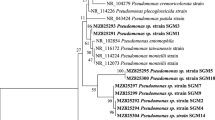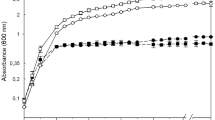Abstract
Over the years several species of edible mushrooms have been collected for consumption from different agro-wastes in Nigeria. Identification of most of these mushrooms was often by morphological descriptive methods. This study reports the morphological study, physiological study and identification of a Nigerian wild strain of Volvariella sp. (VNW) isolated from discarded oil palm waste and three Indian commercial strains V11, V245 and V247 of V. volvacea. Effect of incubation temperatures and medium pH was investigated. Molecular characterization of the strains was carried out using ITS-1 and ITS-4 primers. Results obtained showed close similarities of the Nigerian strain to the Indian strains with few morphological variations in colour, shape and appearance. Growth was observed at temperature range of 20–40 °C and pH range of 4.0–8.0 for all strains with optimum mycelia extension at 35 °C and pH 6.0. VNW recorded a significantly higher (p ≤ 0.05) mycelia extension rate at 35 °C (25.20 ± 1.80 mm/day) and pH 6.0 (40.20 ± 0.34 mm/day). Highest biomass yield was observed at pH 6.0 with V11 recording a significantly (p ≤ 0.05) higher yield (1.74 ± 0.07 g/100 mL). Increasing percentage (w/v) of CaSO4·H2O increased biomass yield of all the strains. NJ phylogenetic tree showed the Nigerian and Indian strains in the same cluster indicating evolutionary closeness than with other species of Volvariella from GenBank in a separate cluster even though they share a common ancestor. This successfully proves the identity of a Nigerian strain of Volvariella sp. VNW from oil palm waste as V. volvacea with GenBank accession number KC894923.
Graphical Abstract








Similar content being viewed by others
References
Ahlawat OP, Pardeep G, Shwet K, Dhar BL (2008) Development of molecular and biochemicalmarkers for selecting a potential high yielding strain of paddy straw mushroom (Volvariella volvacea). J Plant Biochem Biotechnol 17(1):57–63. doi: 10.1007/s12088-011-0126-1
Akinyele BJ, Adetuyi FC (2005) Effect of agrowastes, pH and temperature variation on the growth of Volvariella volvacea. Afr J Biotech 4(12):1390–1395
Alizera B, Morteze RT, Alizera AM, Melin Rad, Gelayol C, Sina KJ (2013) Mushroom poisoning in the Southwest region of the Capsian sea, Iran: a retrospective study. Iran J Toxicol 7(20):798–803
Anderson JB, Stasovski E (1992) Molecular phylogeny of Northern Hemisphere species of Armillaria. Mycologia 84:505–516
Asemota UK, Etim VA, Okereke OE, Abubakar S, Ogbadu GH (2015) Mushroom biotechnology in Nigeria-implications for food security, Environment and public health; a review. J Adv Biol Biotechnol 2(2):96–108. doi:10.9734/JABB/2015/14197
Bankole PO, Adekunle AA (2012) Studies on biodiversity of some mushrooms collected in Lagos State, Nigeria using biotechnological methods. J Yeast Fungal Res 3(4):37–48. doi:10.5897/JYFR12.008
Boa E (2004) Wild edible fungi: (17) a global overview of their use and importance to people. FAO Press, Rome pp 37–78
Bruns TD, White TJ, Taylor JW (1991) Fungal molecular systematics. Ann. Rev. Ecol. Syst. 22:525–564
Buswell JA, Chen M (2005) Cultivation, biochemical, molecular biological and medical aspects of the culinary-medicinal straw mushroom (Bull. Fr.) Singer (Agaricomycetideae). Int J Med Mush 7:157–166
Chang ST (1993) Biology and cultivation technology of Volvariella volvacea. In: Chang ST, Buswell J, Chiu S (eds). Mushroom biology and mushroom products. TheChinese University Press, Hongkong. pp 3–20
Chang ST, Miles PG (2004) Mushrooms—cultivation, nutritional value, medical effect, and environmental impact. CRC Press, Boca Raton, p 451
Chang SC, Steinkraus KH (1982) Lignocellulolytic enzymes produced by Volvariella volvacea, the edible strawmushroom. Appl Environ Microbiol 43:39–44
Chang T, Yau CK (1971) Volvariella volvacea and its life history. Am J Bot 58(6):552–561
Chang ST, Miles PG, Wai CC (1981) A study of monosporous isolates of Volvariella volvacea. Mush Sci 11:603–621
Fasidi IO (1996) Studies on Volvariella esculenta (mass) Singer: cultivation on agricultural wastes and proximate composition of stored mushrooms. Food Chem 55(2):161–163
Fasidi IO, Akwakwa DO (1996) Growth requirements of Volvariella speciosa (Fr. ex. Fr.) Singer, a Nigerian mushroom. Food Chem 55(2):165–168
Fasidi IO, Jonathan SG (1994) Growth requirements of Volvariella esculenta (mass) Singer, a Nigerian edible mushroom. Chem Microbiol Technol Lebensm 16(5/6):151–155
Fasola TR, Gbolagade JS, Fasidi IO (2007) Nutritional requirements of Volvariella speciosa (Fr. ex. Fr.) Singer, a Nigerian edible mushroom. Food Chem 100(3):904–908
Furlong MA, Singleton DR, Coleman DC, Whitman WB (2002) Molecular and culture-based analyses of prokaryotic communities from an agricultural soil and the burrows and casts of the earthworm Lumbricus rubellus. Appl Environ Microbiol 68:1265–1279
Gardes M, Bruns TD (1993) ITS primers with enhanced specificity for basidiomycetes—application to the identification of mycorrhizae and rusts. Mol Ecol 2:113–118
Gbolagade SG, Fasidi IO, Ajayi EJ (2004) Physico-chemical studies on Volvariella esculenta (mass) Singer, a Nigerian edible fungus. Food Chem 85:339–342
Gbolagade J, Ajayi A, Oku I, Wankasi D (2006) Nutritive value of common wild edible mushrooms from Southern Nigeria. Global J Biotechnol Biochem 1(1):16–21
Grion DH (1994) Fungal physiology. Wiley, London, p 214
Gurudevan T, Subbiah K, Karupannan M, Velappa P, Sakthivel K (2012) Improved techniques to enhance the yield of paddy straw mushroom (Volvariella volvacea) for commercial cultivation. Afri J Biotechnol 11(64):12740–12748
Jonathan SG (2002)Vegetative growth requirements and antimicrobial activities of some higher fungi in Nigeria. Ph.D. thesis, University of Ibadan, Ibadan, Nigeria
Jonathan SG, Fasidi IO (2001) Effect of carbon, nitrogen and mineral sources on growth of P. atroumbonata (Pegler), a Nigerian edible mushroom. Food Chem 72:479–483
Jonathan SG, Fasidi IO (2004) Physico-chemical studies on Volvariella esculenta mass (Singer), a Nigerian edible fungus. Food Chem 85:339–342
Jonathan SG, Fasidi IO, Odebode AC (2003) Temperature, pH. phytohormones and vitamin requirements of Lepiota procera (Fr.) S. F. Gray, a Nigerian edible macro-fungus. Adv Food Sci 25(3):87–90
Kalac P, Svoboda L (2000) A review of trace element concentration in edible mushrooms. Food Chem 69:273–281
Kuforiji OO, Fasidi IO (2009) Influence of light and spawn quantity on the growth of Nigerian mushroom Pleurotus tuber-regium. J Environ Biol 30(4):605–608
Largent DL (1977). How to identify mushrooms to genus I. Macroscopic Features, Mad River Press, Eureka, CA p 86
Leatham GF, Stahmann MA (1987) Effect of light and aeration on fruiting of. Lentinula edodes. Trans Br Mycol Soc 88:9–20
Lee JS, Linz MO, Cho KY, Cho JA, Chang SY, Nam DH (2006) Identification of medicinal mushroom species based on nuclear large subunits rDNA sequences. J Microbiol 44:29–34
López GJ, Velázquez CR (2005) A Non-toxic scanning electron microscopy method to study the reproductive structures of agaricales using sample fixationin the field. Carib J Sci 41(4):857–860
Miyazaki Y, Masuno K, Abe M, Nishizawa H, Matsumoto T, Kunitomo S, Sakata H, Nakamura K, Koyama T, Ito M, Kazama H, Suzuki D, Obatake Y, Sano H, Nakamura M, Miyazaki K., Sakamoto Y, Kaneko S., Kamada T (2011) Light-stimulative effects on the cultivation of edible mushrooms by using blue led. Proceedings of the 7th international conference on mushroom biology and mushroom products (ICMBMP7)
Onuoha IC, Ukaulor U, Onuoha CB (2009) Cultivation of Pleurotus pulmonarius (mushroom) using some agrowaste materials. Agric J 4:109–112
Quimo TH (1982) Tropical mushrooms: biotechnological nature and cultivation methods. The Chinese University Press, Hong Kong pp 128–134
Ramkumar L, Ramanathan T, Nedumaran T (2011) In vitro effect of organic and inorganic additives from the production of radial mycelial growth and lignocellulolytic enzyme in Lentinus edodes (Berk.) Sing. Emir J Food Agric 23(1):71–79
Read ND, Porter R, Beckett A (1983) A comparison of preparative techniques for the examination of the external morphology of fungal material with the scanning electron microscope. Can J Bot 61(8):2059–2078
Reyes RG, Abella EA (1997) Mycelial and Basidiocamp performance of P. sajor-caju on the mushroom spent of V. volvacea. Proceedings of international seminar on the Development of Agribusiness and its impact on Agricultural Production in Southeast Asia. Tokyo, NODA1 Press. pp 491–497
Roy A, Prasad P, Gupta N (2014) Volvariella volvacea: a macrofungus having nutritional and health potential. Asian J Pharm Tech 4(2):110–113
Sakamoto Y (2004) Influence of light on the morphological changes that take place during the development of the Flammulina velutipes fruit body. Mycoscience 45:333–339
Salazar O, Schneider JHM, Julian MC, Keijer J, Rubio V (1999) Phylogenetic subgrouping of Rhizoctonia solani AG2 isolates based on ribosomal ITS sequences. Mycologia 91(3):459–467
Samajpati N (1982) Mushroom cultivation and rural development. Mush Newslett Tropics 2:1–2
Sasidhara R, Thirunalasundari T (2012) Molecular characterization of mushroom. Euro J Exp Bio 2(2):369–373
Shrestha B, Lee WH, Han SK, Singh JM (2006) Observation on some of the mycelia growth an d pigmentation characteristics of Cordyceps militaris isolates. Microbiol 34(2):83–91
Stamets P (1993) Gowing gourmet and medicinal mushrooms. Ten Speed Press, Hong Kong
Tamura K, Peterson D, Peterson N, Stecher, G, Nei M, Kumar S (2011) MEGA5: molecular evolutionary genetics analysis using maximum likelihood, evolutionary distance, and maximum parsimony. Mol Biol Evol 28:2731–2739
Tharun G (1993) Promotion of mushroom production and bioconversion of wastes for income generation in rural areas. CDG 3EAPO’s biotechnology training project. In: Chang ST. Bussivell JA, Chril S (eds). Mushroom biology and mushroom products. The Chinese University Press, Hong Kong pp 307–318
Thompson JD, Higgins DG, Gibson TJ (1994) Improved sensitivity of profile searches through the use of sequence weights and gap excision. Comput Appl Biosci 10(1):19–29
Tsai YL, Olson BH (1991) Rapid method for direct extraction of DNA from soil and sediments. Appl Environ Microbiol 56:1070
Ukoima HN, Ogbonnaya LO, Arikpo GE, Ikpe FE (2009) Cultivation of mushroom Volvariella volvacea on various farm wastes in Obrubra local government of cross rivers state, Nigeria. Pak J Nutr 8(7):1059–1061
White TJ, Bruns T, Lee S, Taylor, Jr (1990). Amplification and direct sequencing of fungal ribosomal RNA genes for phylogenetics. In: Innis MA et al (eds) PCR protocols, a Guide to methods and applications. Academic Press, New York, pp 315–322
Wiegant WM, Wery J, Burtenhuis ET, De Bout AM (1992) Growth-promoting effect of thermophylic fungi on the mycelium of the edible mushroom Agaricus bisporus. Appl Environ Microbiol 58(8):2654–2659
Zervakis G, Philippoussis A, Ioannidou S, Diamantopoulou P (2001) Mycelium growth kinetics and optimal temperature conditions for the cultivation of edible mushroom species on Lignocellulosic substrates. Folia Microbiol 46(3):231–234
Acknowledgements
The Third World Academy of Sciences (TWAS), Italy is gratefully acknowledged for the award of one year postgraduate fellowship (FR No. 3240257248-TWAS/ R & A T 2011) utilized at the Department of Agricultural Biotechnology, Assam Agricultural University (DBT-AAU), Jorhat, India under the guidance of Prof. Madhumita Barooah. The host institution (AAU) is appreciated for support and provision of facilities, likewise the authority of Ladoke Akintola University of Technology (LAUTECH), Ogbomoso, Nigeria is appreciated for the study leave granted. North-Eastern Hill University (NEHU), Shillong, India, is also acknowledged for the permission granted to use the Scanning Electron Microscopy facility.
Author information
Authors and Affiliations
Corresponding author
Rights and permissions
About this article
Cite this article
Adewoyin, A.G., Barooah, M., Oloke, J.K. et al. Identification and physiological properties of a Nigerian strain of Volvariella sp. isolated from oil palm waste. World J Microbiol Biotechnol 33, 135 (2017). https://doi.org/10.1007/s11274-017-2293-7
Received:
Accepted:
Published:
DOI: https://doi.org/10.1007/s11274-017-2293-7




